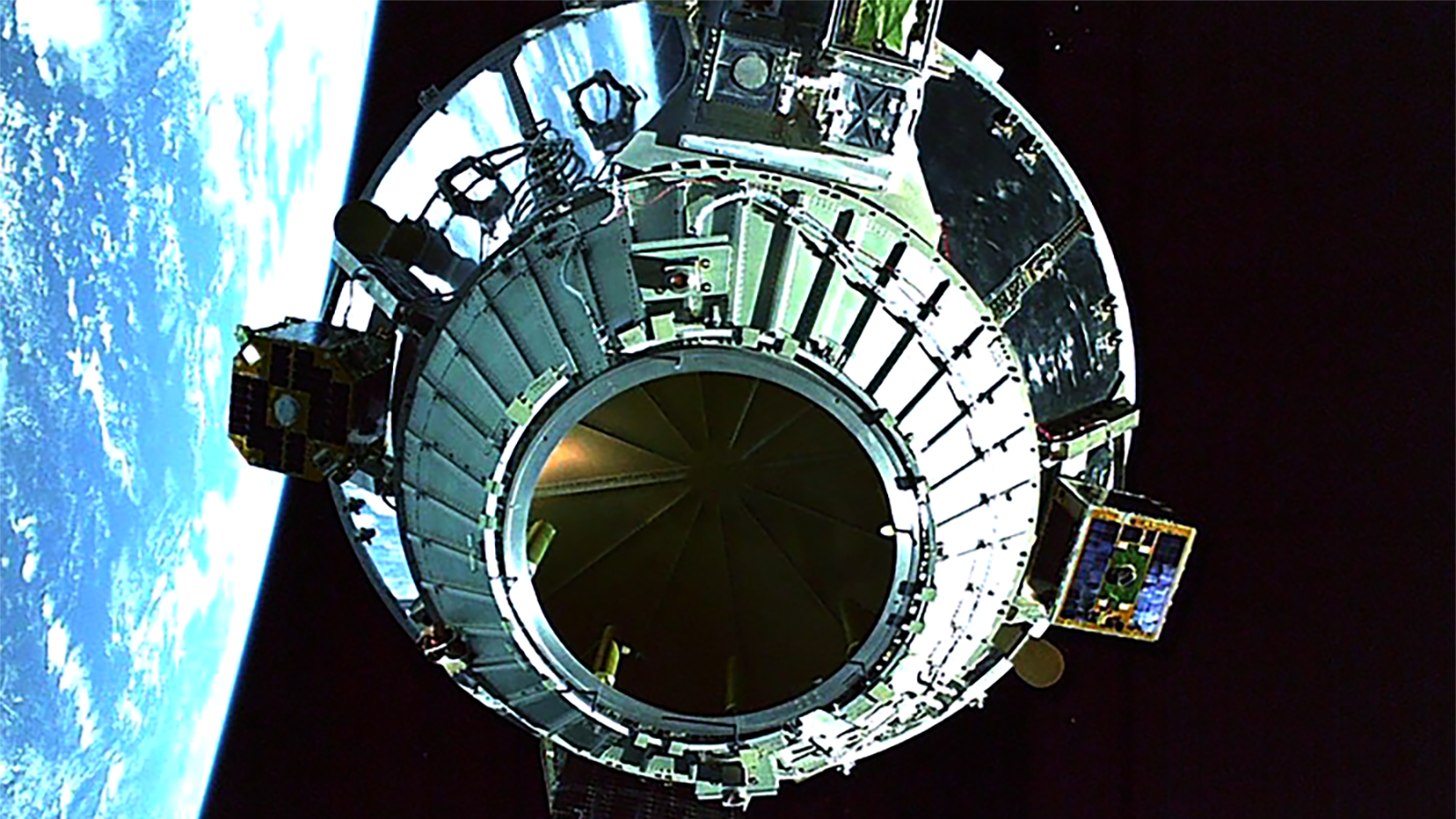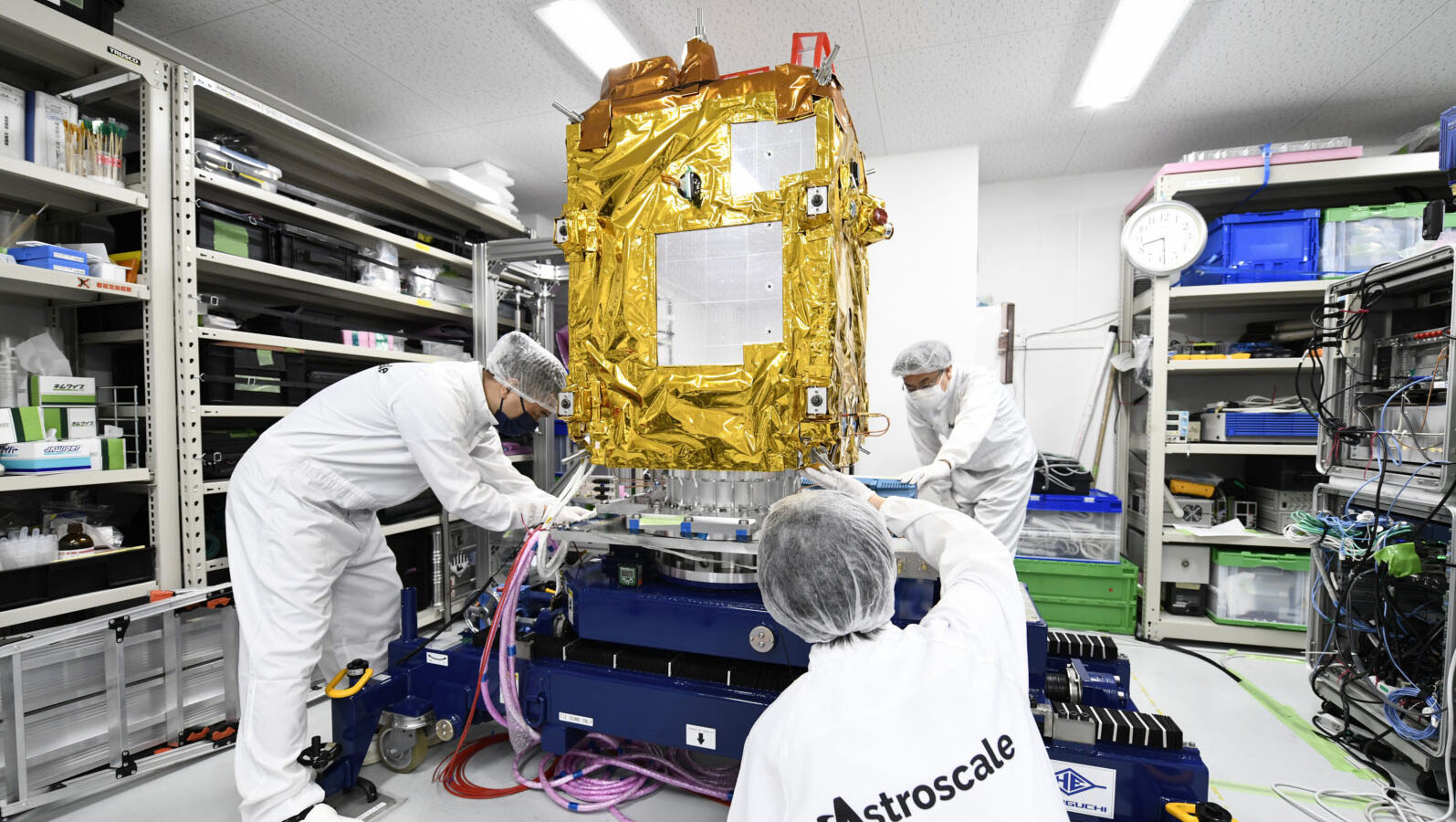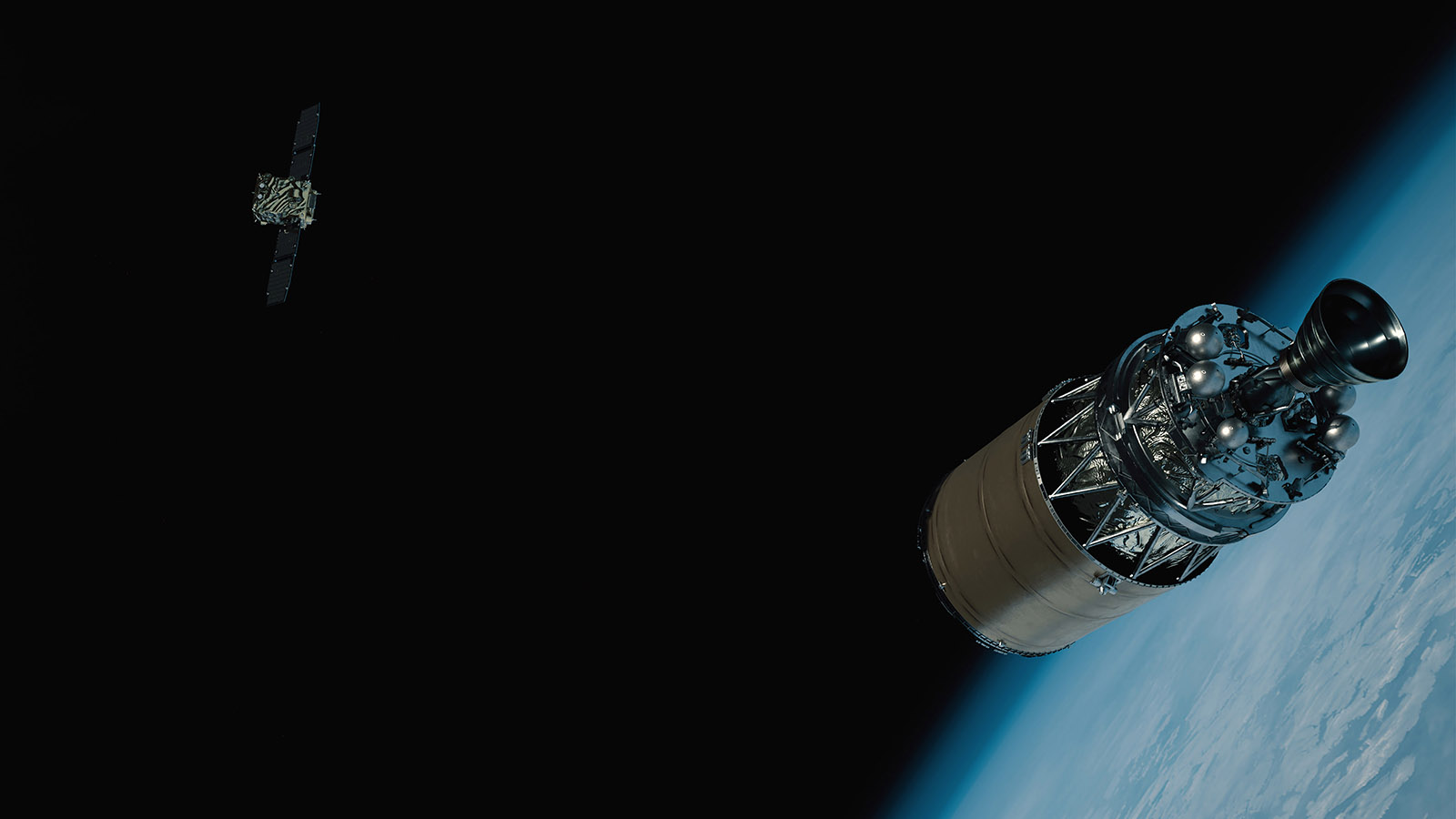Stay Up to Date
Submit your email address to receive the latest industry and Aerospace America news.
Astroscale is poised to embark on the next step in proving its business plan of grappling and removing orbital debris: sending a spacecraft to inspect an uncontrolled rocket stage in preparation for a future capture mission. Navigating up to and around such an object requires an intricate choreography of sensors, cameras and navigation algorithms. Keith Button tells the story.
Catching a piece of space junk without crashing into it is tricky. You need a spacecraft that can navigate to the debris from thousands of kilometers away, then autonomously view it and sidle up to it as you both orbit at about 7.5 kilometers per second, though the junk is likely tumbling and at an unknown rate. This spacecraft needs to perform “a very careful and precise dance to get really close,” says Mike Lindsay, chief technology officer for Astroscale, a Tokyo-based, venture capital-backed company planning what would be the first commercial mission to closely approach a piece of space debris.
Astroscale engineers plan to demonstrate such a dance at a date to be decided early this year, with the launch of a camera and autonomous navigation equipped spacecraft from New Zealand by Rocket Lab, which specializes in launching small satellites, like the refrigerator-sized ADRAS-J, short for Active Debris Removal by Astroscale-Japan. If they are successful, the stage will be set for a planned follow-on mission to grab and remove a piece of junk from orbit — the same 11-meter-long spent H-IIA upper stage that ADRAS-J is aiming for. This rocket stage, from a 2009 launch for JAXA, the Japan Aerospace Exploration Agency, is one of the largest of about 60 still in orbit from past JAXA missions.
A reliable method for space debris removal — capturing an object and pushing it downward to fall back into the atmosphere and burn up — would reduce the risk of collision for the rapidly growing ranks of active satellites, which the European Space Agency now places at about 9,000 strong. Fewer collision risks would also save satellite operators time and the need to burn valuable fuel to steer their craft to avoid potential collisions. About 35,000 pieces of space debris — all larger than 10 centimeters — are tracked by networks of ground-based radar and telescopes, with an estimated 1 million pieces in the 1-cm to 10-cm range, and 130 million pieces at 1 millimeter to 1 cm.

ADRAS-J must avoid colliding with the JAXA stage and contributing more pieces of debris to the total. How bad could a mistake be? Jonathan McDowell of the Harvard-Smithsonian Center for Astrophysics in Cambridge, Massachusetts, predicts that any debris created by a collision between a spacecraft and another object with a closely matched orbital path and velocity would be relatively minor when compared to something like the 2009 collision of an Iridium satellite and a deactivated Russian satellite. That incident created 2,000-plus pieces of trackable debris. That’s largely because of the estimated speed of such a hypothetical collision. For instance, if a stuck thruster were to accelerate a spacecraft for several minutes before it crashed into an object with which it was trying to rendezvous — and trying to match orbits and velocities — the relative difference in velocity might reach 160 kilometers per hour, compared to the 42,000 kph relative difference in velocity for the Iridium and Cosmos satellites in the 2009 collision.
“As we do our approach, safety is the No. 1 priority,” says Astroscale’s Lindsay, who is based in Tokyo. To avoid colliding with the JAXA rocket stage, ADRAS-J must remain in a “passively safe orbit” that won’t cross the orbit of the stage if Astroscale loses control of or communication with the satellite and can no longer control the trajectory. The engineers performed thousands of computer simulations of every trajectory or perturbation they could think of for every phase of the mission “to make sure that if the maneuver doesn’t go exactly as planned or there’s an anomaly, the maneuver puts us on to a trajectory that’s not going to be an issue,” Lindsay says.
While opinions vary about the viability of debris removal as a commercial service, there’s broad consensus that even small pieces are potentially lethal to satellites. These fragments are what you think about “if you’re an astronaut on the [International] Space Station and you’re worrying about what might go through me like a bullet in the next 10 minutes,” McDowell says. Removing the largest pieces from orbit would do the most good, since that would reduce the odds of collisions with other large objects that could break into hundreds of thousands of fragments. Such removal would also help avoid the feared Kessler Syndrome, a predicted cascading series of collisions now in its infancy that over the coming decades could create such a cloud of fragments that certain orbit altitudes would be uninhabitable for satellites.
“If what you’re worried about is some long-term chain reaction, then you want to go for a few big objects rather than a lot of small objects,” McDowell says.
He continues: “As you study the history of space exploration and the population of orbital objects, you can’t avoid becoming concerned about the increasing number of near misses and the potential for collisions and for bad consequences from space debris. Now it’s time to actually start getting rid of the debris, and in particular, the bigger chunks of debris.”
For the JAXA-funded ADRAS-J mission, Astroscale plans to build on the results of its 2021-2022 mission, ELSA-d, short for End-of-Life Services by Astroscale -demonstration. For ELSA-d, Astroscale demonstrated that a “servicer” spacecraft could repeatedly approach and dock with an uncontrolled mock “client” satellite via a magnetic docking plate installed on the client prior to launch. The spacecraft were launched in the same stack and separated once in orbit. In the final portion of the mission, the servicer separated from the client by 1,700 kilometers and navigated to within 159 meters of it, despite the failure of four of its eight thrusters. Since this demonstration, one broadband constellation operator has committed to installing Astroscale’s docking plates on its satellites.
With ADRAS-J, Astroscale wants to show that the sensors and algorithms updated from ELSA-d can track an object from a longer distance. The plan is to maneuver the spacecraft around the spent JAXA stage so ADRAS-J can scan the stage from all angles from a few dozen meters away with visual and infrared cameras, lidar and laser range finders. Those scans are intended to show engineers what axis the stage is spinning around, how fast it is spinning and the condition of its surfaces — all important details for planning how robot arms might catch the debris on the subsequent mission.
“We would want to, in the inspection mission, make sure that the part that we want to grab on to is going to be unobstructed; not damaged; it’s not going to fall off once we grab it,” Lindsay says. Astroscale is designing a spacecraft for the follow-on debris capture mission, and JAXA has selected the company for a technology study for that mission, but the space agency has not yet awarded Astroscale a contract to conduct this demonstration.
For ADRAS-J, Astroscale’s engineers have a good idea of the rocket stage’s orbit, based on periodic updates of its position from the U.S. Space Surveillance Network via the space-track.org website. The network tracks active satellites and the thousands of pieces of debris larger than 10 cm with radar and telescopes. While the tumble rate of an orbiting object can be determined from the alternating brightness of the object as viewed from the ground, the task for most of the telescopes that are aimed at space debris is merely to track the orbits of these objects — so they know it’s tumbling, but not how fast. But because of natural forces causing drift in the orbit, the predicted pathway of the JAXA stage isn’t as accurate as it would be if it had GPS, as most satellites launched today have, so Lindsay says the estimated position could be off by several kilometers. The engineers coordinated with Rocket Lab to plan to launch ADRAS-J on a trajectory to position it in an orbit close to that of the spent stage, about 600 km above Earth.

After launching, plans call for firing the thrusters positioned on each corner of the rectangular spacecraft to shift its orbit closer and closer to that of the target. Astroscale will know the ADRAS-J orbit from its onboard GPS receiver and the rocket stage’s estimated orbit based on the position updates from the Space Surveillance Network. From “several tens of kilometers” away, ADRAS-J with its cameras will see reflected light from the stage, and at about 2 kilometers away, the stage will look like a bright dot. At that point, ADRAS-J will switch its navigation technique, basing its navigation on its position relative to the stage instead of GPS position. Then, it will close the distance until it is a few dozen meters away from the stage and autonomously remain at that fixed distance.
To prepare for this planned navigation transition, the engineers trained ADRAS-J’s onboard navigation algorithms to calculate the predicted path of the JAXA stage based on its motion relative to the star field behind it, Lindsay says. “You have to do these very precise calculations based on a speck of light.”
The algorithm will then predict where it thinks the debris is going, telling itself: “We have this uncertainty; let’s put ourselves into this trajectory to get a little bit closer,” Lindsay says. “So maybe you cut the distance in half, and at that point, you can make a better assessment of where it is.”
The algorithm loop will repeat itself: checking the sensor images of the stage, guessing the position and pathway of the stage, firing its thrusters to get closer and checking again, he says. “It’s this constant iterative process of making better and better guesses essentially of where the object is going and where it is, until you get close enough that you have resolved imagery and you’re like, ‘OK, I definitely know where it is; I know exactly how far it is; I can get really close if I want to, and I can do it safely.’”
Before the spacecraft was prepared for launch, planners also needed to find out how the control algorithms and sensors would respond to various lighting conditions in space. For that, they ran several ground tests at JAXA’s Tsukuba Space Center in October 2022, April 2023 and July 2023. In one test, they set up at one end of a 10-m-long corridor a mock-up of a launch adapter ring from the stage, made of aluminum surrounded by gold-foil-colored multilayer insulation. At the other end was a platform on wheels, like a dolly, carrying the ADRAS-J sensors.
Electric motors on the dolly were directed by the ADRAS-J control algorithms to move the sensor platform in all four directions, with some rotation as well, to mimic orbital mechanics, changes in position relative to the stage mock-up and changes in velocity that the thrusters would initiate in space as the spacecraft maneuvered closer and closer to the stage. All the lights were shut off except for a sun simulator, and the engineers tested how the sensors responded to different angles of glare: the sun shining from behind the stage, directly in front of it or from the side.
“We wanted to test — to the limits — the instruments’ responses and different lighting conditions and angles, specular reflections,” Lindsay says. “Part of our mission is to assess whether the upper stage would be safe to grapple, and the adapter ring is an ideal place for this. If we do want to grapple the ring, we also need to accurately track and approach the ring while zeroing relative velocity. So we need good practice on determining the motion of this feature so we can safely dock with it.”
Once ADRAS-J is orbiting next to the JAXA stage, controllers on the ground will command its sensors to record images and take measurements from fixed positions around the stage. The spacecraft will then make 360-degree flyarounds, slowly circling the stage to capture data from different angles and in various lighting conditions. The spacecraft’s control algorithms are designed to execute the maneuvers and make small adjustments to maintain a safe distance, Lindsay says.
The sensor data from ADRAS-J will help Astroscale design the spacecraft for the future capture mission, assuming that it wins the JAXA contract, as well as other potential missions to capture, repair or refuel other satellites for other prospective clients, Lindsay says. For the JAXA capture mission, the ADRAS-J imaging is expected to reveal the specific rate at which the stage is spinning. So if the spin rate is 2 degrees per second, for example, engineers won’t have to design robot arms for the follow-on mission that will function over a full 1- to 3-degrees-per-second range, Lindsay says.
“If at rendezvous you can narrow that range down, you can home in on the exact type of algorithm we need or thruster technology that engages the specific solution, so you’d have a spread of capability,” he says. “You just have to launch whatever’s needed to do the job.”
The ADRAS-J results will define how much sensor data is necessary to capture the stage or for other debris-capture or satellite-servicing missions, as well as what types of sensors are essential for identifying certain features of the orbiting object or to match the actual object to its computer model, Lindsay says. “You don’t want to get up there and realize you can’t see what you need to see because you don’t have the right kind of data collected.”
After years in space, an orbiting object’s colors and other features may have been changed by atomic oxygen, radiation, ultraviolet light and micro impacts from orbiting dust. “When we make our simulations on the ground of what an object is going to look like and how we use our computer vision to see and understand the object, we are using models based on what we think the material looks like on the ground,” Lindsay says. “I may need both visual and infrared to get a lock on features or a contrast of features on the client object to match the model.”
If Astroscale can prove that it can capture space junk and take it out of orbit, is there a market for the service? Company executives think so.
Speaking to reporters during an October webinar, Chief Operating Officer Chris Blackerby said he expects that government contracts for research and proving technology for debris capture will help generate commercial demand that doesn’t exist today. “It’s a nascent market; we recognize that. As with any deep-tech, new-market ecosystem, there’s going to be some hesitance among the commercial sector to buy into it immediately.”
As for government projects, Astroscale — which has raised $383 million in venture capital to date — is developing a debris removal mission for the U.K. Space Agency and a refueling prototype for the U.S. Space Force’s Space Systems Command, as well as an inspection mission for the Japan Ministry of Education, Culture, Sports, Science and Technology. On the commercial side, broadband constellation operator OneWeb has installed magnetic plates on its satellites that are compatible with the docking spacecraft that Astroscale demonstrated in its ELSA-d mission, which could allow for easier capturing and deorbiting in the future if those satellites don’t fall out of orbit and burn up as they are designed to.
Still, not everyone is convinced there is a viable commercial market, because in the most popular orbiting altitude — between 400 and 600 km — there hasn’t been any debris hazardous enough to spark satellite operators to pay for its removal. But governments might pay for removal or force owners to clean up their own wayward satellites to avoid fines, McDowell says. In October, the U.S. Federal Communications Commission fined DISH Network $150,000 for failing to properly relocate one of its geosynchronous television satellites to an assigned graveyard orbit, the agency’s first space debris enforcement.
The incentive “may have to come from government, possibly through taxing the satellite operators,” McDowell says. “The only reason a commercial operator is going to pay to remove debris is if the government fines you.”
“If what you’re worried about is some longterm chain reaction, then you want to go for a few big objects rather than a lot of small objects.”
Jonathan McDowell, Harvard-Smithsonian Center for Astrophysics
About Keith Button
Keith has written for C4ISR Journal and Hedge Fund Alert, where he broke news of the 2007 Bear Stearns hedge fund blowup that kicked off the global credit crisis. He is based in New York.
Related Posts
Stay Up to Date
Submit your email address to receive the latest industry and Aerospace America news.




